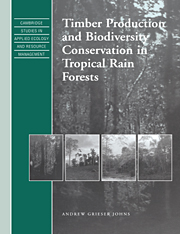Book contents
- Frontmatter
- Contents
- Foreword
- Preface
- Explanatory note
- 1 The issues
- 2 The history and development of tropical forestry
- 3 Changes in the physical environment
- 4 Forest regeneration and gap dynamics
- 5 Responses of individual animal species
- 6 Responses of species assemblages
- 7 Using ecological data in forest management planning
- 8 Intervention to maintain biodiversity
- 9 Field procedures
- 10 The future
- References
- Subject index
9 - Field procedures
Published online by Cambridge University Press: 04 December 2009
- Frontmatter
- Contents
- Foreword
- Preface
- Explanatory note
- 1 The issues
- 2 The history and development of tropical forestry
- 3 Changes in the physical environment
- 4 Forest regeneration and gap dynamics
- 5 Responses of individual animal species
- 6 Responses of species assemblages
- 7 Using ecological data in forest management planning
- 8 Intervention to maintain biodiversity
- 9 Field procedures
- 10 The future
- References
- Subject index
Summary
Damage limitation
Reduced-impact logging is considered essential if tropical forestry operations are to be improved (Palmer & Synnot 1992). The effects of uncontrolled logging on tree regeneration in particular, and on biodiversity and ecosystem function in general, are unnecessarily detrimental to long-term sustainability of both timber production and maintenance of the ecosystem.
In areas of intensive logging, such as Sabah, a correlation has been suggested between damage levels and the basal area of timber extracted (Nicholson 1958). While the ecological and environmental impact of logging on a regional or forest-type level is broadly related to logging intensity, there is a poor overall correlation due to different local factors (e.g. logging damage in Amazonian várzea is much lower than expected due to the use of waterborne log transport). The general correlation seen among intensive logging operations is due primarily to the fact that most pay scant attention to reducing the incidental damage associated with felling and skidding. Potential minimum damage levels, which can be calculated from a simple model, have generally not been achieved in commercial operations, with the exception of those in Queensland (Fig. 9.1).
Damage limitation is a standard management procedure in most temperate forestry operations (Bol & Beekman 1989). Where such measures have been applied experimentally to tropical forests, damage levels have been reduced by as much as 50% (Marn 1982; Jonkers 1987; Malvas 1987; Hendrison 1990). Applying such measures has been shown to reduce economic costs in the above studies, which are based on small experimental plots.
- Type
- Chapter
- Information
- Publisher: Cambridge University PressPrint publication year: 1997



